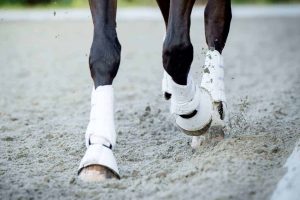Do Bisphosphonates Damage Horses’ Joint Cartilage?

A team of Michigan State University (MSU) researchers recently performed an in vitro (in the lab) study to find out, and PhD candidate and co-author Fernando B. Vergara-Hernández, DVM, shared their findings at the Equine Science Society’s 2021 virtual symposium.
To review, bisphosphonates are synthetic organic compounds that inhibit osteoclastic resorption. Basically, they’re designed to prevent bone breakdown. The two drugs the FDA has approved to treat signs of navicular disease in horses over the age of 4 are clodronate disodium (Osphos) and tiludronate disodium (Tildren). The bisphosphonate the researchers assessed in this study was clodronate disodium—the one that’s been detected in synovial fluid post-IM administration.
Because no published research has evaluated the effects of bisphosphonates on horses’ joint tissues, “the objective of our study was to determine the effects of clodronate disodium on normal and inflamed equine cartilage in vitro,” said Vergara-Hernández.
In the study, his team harvested visually normal cartilage from the left and right stifles of three horses euthanized for reasons other than stifle osteoarthritis. After 24 hours, they subjected the samples to six treatments:
- Control (complete media);
- Equine recombinant interleukin-1 beta (rEqIL-1B, to induce an inflammatory response);
- Low-dose (5 ng/ml) clodronate disodium;
- High-dose (50 ng/ml) clodronate disodium;
- Low-dose clodronate disodium plus rEqIL-1B; and
- High-dose clodronate disodium plus rEqIL-1B.
The team treated cartilage cultures again at 48 hours and 72 hours, then analyzed each set for glycosaminoglycan (GAG, an indicator of cartilage breakdown) and nitric oxide (NO, an indicator of pain and inflammation) content.
As expected, said Vergara-Hernández, GAG and NO levels increased in the rEqIL-1B-treated group. Neither clodronate disodium treatments resulted in increased GAG or NO, indicating it did not negatively affect the cartilage.
“However, the treatment with rEqIL-1B and clodronate disodium did not result in a decrease in production of nitric oxide of GAG content as we were expecting,” he noted.
So while they found no evidence of cartilage toxicity from clodronate disodium, said Vergara-Hernández, the drug does not appear to have anti-inflammatory or protective effects on joints in vitro at the concentrations assessed.
“Future studies should explore further the effects of clodronate disodium and measure in vivo models of joint inflammation,” he said, adding that teams from MSU and Texas A&M are collaborating on just such as project.
If you’re interested in viewing presentations from the 2021 Equine Science Society Virtual Symposium, you can register for the symposium until Aug. 2, 2021, and recordings are available for viewing until Sept. 3, 2021.

Related Articles
Stay on top of the most recent Horse Health news with

















